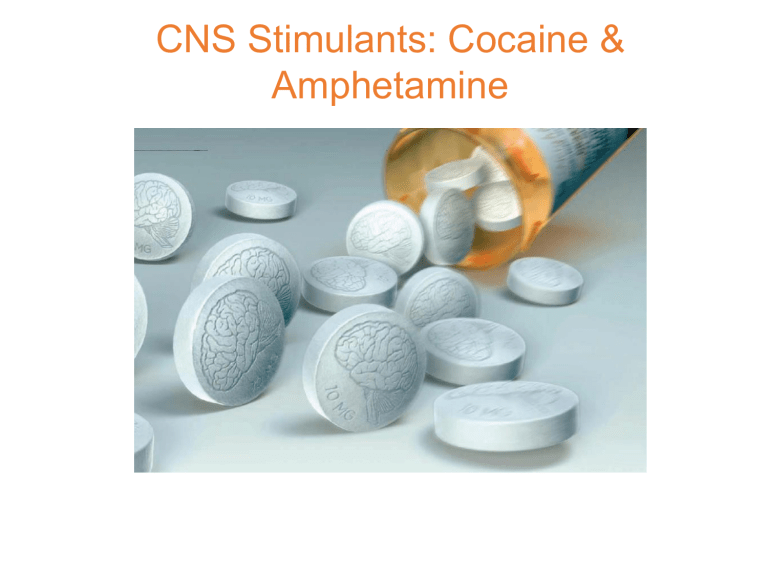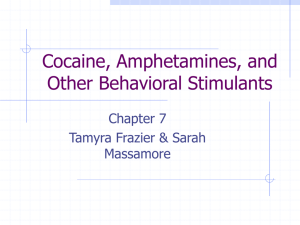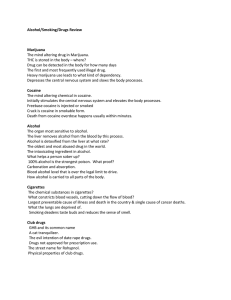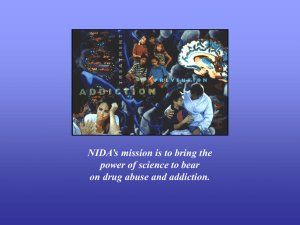
CNS Stimulants: Cocaine & Amphetamine Cocaine Cocaine • Cocaine is an alkaloid found in the leaves of the shrub Erythroxylon coca. • It is native to South America and is cultivated in the northern and central Andes Mountains. • The practice of chewing coca leaves began as early as 5000 years ago. • After the Spanish conquest, coca chewing was discouraged by the Catholic church, until it was realized that without coca, Incan workers lacked the endurance needed to work long hours in the mines and fields at high altitudes and with little food. Cocaine • By the 1850s, German chemists had isolated and characterized cocaine. • Cocaine use became popular as many doctors and scientists lauded its properties. • The most famous user was Sigmund Freud. He recommended it for treating many ailments, and declared that it was non-addictive. • Cocaine also became popular in the U.S. and was used in many medications. • In 1886, Coca Cola was introduced, containing caffeine and cocaine. It was marketed as an alternative to alcohol as the temperance movement gained strength. Cocaine • Coca Plant (chewed to prevent high-altitude sickness, 0.6-1.8% cocaine) • Admin. Route: oral/nasal/IV/inhaled • Interacts with several neurotransmitter systems • Effects appear within seconds minutes, last a couple of hours max. Effects: • Mood amplification (euphoria/dysphoria) • Heightened energy • Sleep disturbance • Motor excitement • Talkativeness • Hyperactive ideation • Increased sexual interest • Inflated self-esteem Insomnia, irritability, anxiety, anger, motor stereotypies, incoherent speech, disjointed flight of ideas, decreased sexual interest, violence, anorexia, delusions of grandiosity Pharmacokinetics of Cocaine • The cocaine alkaloid is extracted from coca leaves and then converted to a hydrochloride (HCl) salt and crystallized. • Cocaine HCl is can be taken orally, intranasally (snorting), or by IV injection. • It is not heat-stable, and cannot be smoked. • Crack cocaine: Cocaine HCl is dissolved in water, ammonia is added, cocaine base extracted with an organic solvent, typically ether. • Dissolved cocaine HCl is mixed with baking soda, heated & dried. Chunks of the dried, hardened mixture are known on the street as crack. • Cocaine is lipophilic (fat-soluble) and passes readily through the blood–brain barrier. • Smoking results in a large surge of cocaine in the brain that is not reflected in peripheral blood concentrations. • Rapid entry into the brain is believed to be an important factor in the strong addictive properties of crack cocaine. Recently, smoking “crack” cocaine has driven a new epidemic of cocaine use. Crack Cocaine • • • • • • • • • • Euphoria/Dysphoria Supreme confidence Loss of appetite Insomnia Alertness Increased energy Craving for more cocaine Potential paranoia Depression “High” lasts only 5-10 min Cocaine: Pharmacokinetics • e1/2 = 0.5-1.5 hrs Cocaine: Pharmacokinetics Cytotoxic! + Cocaine metabolites are produced in humans by CYP3A4 and reaction of cocaine with alcohol (catalyzed by liver carboxylesterase 1, hCE-1). Metabolites such as benzoylecgonine persist and can be detected in the urine for several days. Hou et al.,Biochemical Journal, 2014 Cocaine: Pharmacodynamics • Cocaine increases synaptic DA levels by binding to the plasma membrane DA transporter and blocking reuptake of the neurotransmitter. • Cocaine also blocks reuptake of 5-HT & NE. • Affinity to 5-HT transporter is highest • Block of DA reuptake is mostly responsible for stimulating, reinforcing, and addictive properties. • At high concentration, cocaine inhibits voltage-gated Na+ channels => analgesia Cocaine: Pharmacodynamics • Cocaine also blocks NE reuptake by the NE transporter (NET). • The increased glutamatergic activity causes stimulation of VTA dopaminergic neurons and elevated release of DA in the NAcc. • This model supports a significant role of NE and adrenergic receptors in the effects of psychostimulants. Cocaine: Pharmacodynamics • • • • Parasagittal section of a rodent brain illustrates a circuit that includes the locus coeruleus (LC), prefrontal cortex (PFC), ventral tegmental area (VTA), and nucleus accumbens (NAcc). Noradrenergic fibers from the LC project to the PFC, where they release norepinephrine (NE) onto excitatory a1-adrenergic receptors on glutamatergic pyramidal neurons. This effect is augmented by cocaine’s ability to block NE reuptake by the NE transporter (NET). The increased glutamatergic activity causes stimulation of VTA dopaminergic neurons and elevated release of dopamine (DA) in the NAcc. Pena et al. 2015 Cocaine: Side Effects of Chronic Use (incr. white blood cell count) (itching) By Mikael Häggström, used with permission Amphetamines 2nd most used illicit drug worldwide (after cannabis) Amphetamines (methyl group) Amphetamine is the parent compound of a family of synthetic psychostimulants that are structurally related to DA. Amphetamines • • • • • • • • • • • • • • • Khat Plant (Catha edulis) Admin. Route: oral/IV/subcutaneously Interact with several neurotransmitter systems Effects appear within seconds minutes, last many hours (e1/2 = 7 – 30 hrs) Weak base with a pKa of 9.9, when the pH is basic, more of the drug is in its lipid soluble free base form, and more is absorbed through the lipid-rich cell membranes of the gut epithelium Metabolized in liver by CYP2D6 Excretion: Kidneys Heightened alertness Heightened energy Sleep disturbance Motor excitement Talkativeness Increased sexual interest Increased confidence Exhilaration Side effects (prolonged use) Insomnia, irritability, anxiety, anger, motor stereotypies, decreased sexual interest, violence, anorexia, psychosis, paranoia, hallucinations, neurotoxicity (methamphetamine) Methamphetamine Leuckart reaction: • One equivalent of phenylacetone is reacted with two equivalents of N-methylformamide to produce the formyl amide of methamphetamine plus carbon dioxide and methylamine as side products, and an intermediate which is reduced by the second equivalent of N-methylformamide. • The intermediate formyl amide is then hydrolyzed under acidic aqueous conditions to yield methamphetamine as the final product. • Alternatively, phenylacetone can be reacted with methylamine under reducing conditions to yield methamphetamine. Amphetamines in History The German chemist Friedrich Hauschild had been aware of the American amphetamine Benzedrine ever since the drug has been used as a doping product in the Olympic Games in Berlin in 1936. The following year he managed to synthesize methamphetamine, a close cousin of amphetamine, while working for Temmler-Werke, a Berlin-based pharmaceutical company. Temmler-Werke began selling methamphetamine under the brand name Pervitin in the winter of 1937. Partly thanks to the company’s aggressive advertising campaign, Pervitin became well known within a few months. The tablets were wildly popular and could be purchased without a prescription in pharmacies. One could even buy boxed chocolates spiked with methamphetamine. But the drug’s most important use was yet to come. KILLER HIGH: A HISTORY OF WAR IN SIX DRUGS, PETER ANDREAS, OXFORD UNIVERSITY PRESS 2020; TIME MAGAZINE, JANUARY 7, 2020 Amphetamines in History In The Art of War, Sun Tzu wrote that speed is “the essence of war.” While he of course did not have amphetamines in mind, he would no doubt have been impressed by their powerful war-facilitating psychoactive effects. Amphetamines—often called “pep pills,” “go pills,” “uppers” or “speed”—are a group of synthetic drugs that stimulate the central nervous system, reducing fatigue and appetite and increasing wakefulness and a sense of well-being. The quintessential drug of the modern industrial age, amphetamines arrived relatively late in the history of mind-altering substances—commercialized just in time for mass consumption during World War II by the leading industrial powers. Japanese, American and British forces consumed large amounts of amphetamines, but the Germans were the most enthusiastic early adopters, pioneering pill-popping on the battlefield during the initial phases of the war. That war was not only the most destructive war in human history but also the most pharmacologically enhanced. It was literally sped up by “speed.” KILLER HIGH: A HISTORY OF WAR IN SIX DRUGS, PETER ANDREAS, OXFORD UNIVERSITY PRESS 2020; TIME MAGAZINE, JANUARY 7, 2020 Methamphetamine: Impact on Society “Meth Houses” • While home meth production has declined since 2004, the DEA reports that thousands of homes seized since then could still be contaminated (2017). • Only 27 states require this information to be disclosed. • Meth labs leave a signature scent. Sniff for any suspicious smells like ammonia, rotten eggs, or vinegar. • Buy a test kit. Meth test kit Drug Enforcement Administration, “2017 National Drug Threat Assessment” Chronic Use of Amphetamines • Oxidative stress, excitotoxicity, neuroinflammation, mitochondrial dysfunction • Cardiovascular problems: elevated blood pressure, atherosclerosis, heart attack, stroke • Anorexia • Physical deterioration, skin lesions Six months later…. Amphetamines: Pharmacodynamics • Blocks monoamine NT reuptake like cocaine (both DAT & NAT!) • Additionally, amphetamine and methamphetamine also increase monoamine NT release by inverting the transporter => more potent • The combined effect of these processes is a massive increase in synaptic DA levels. • NA-releasing effects of amphetamines occur in the brain and in the sympathetic nervous system. • Consequently, these compounds have potent sympathomimetic actions, similar to those seen with cocaine. Disorders of Attention - ADHD Inattention, hyperactivity, impulsivity Disorders of Attention - ADHD Inattention, hyperactivity, impulsivity The gender gap in ADHD diagnosis De Rossi P et al. J Clin Med 2022; 11: 385 Boys with suspected ADHD are typically more likely to be referred for clinical evaluation than girls. This might be because boys with ADHD appear to show more disruptive and externalizing behavior than girls with ADHD (Gaub & Carlson, 1997), and it is believed that this may leave many school-age and adolescent girls with ADHD undiagnosed. Disorders of Attention - ADHD Main comorbid psychiatric disorders in adult ADHD. Kooij JJS et al. J Atten Disord 2012; 16(5 Suppl): 3S-19S. Diagnostic Criteria - ADHD Management recommendations are included for all age groups in the NICE guidelines 2018, covering nonpharmacological and pharmacological therapies. Diagnostic Criteria - ADHD Children with ADHD aged <5 years: •Parents/carers of children under 5 years of age with ADHD are recommended to be offered an ADHD-focused group training program as first-line treatment. •If ADHD symptoms still cause significant impairment in the child after group parental training and environmental modifications, a specialist ADHD service with expertise in managing ADHD in young children may be approached. •Medication for ADHD is not recommended for any child aged <5 years without a secondary specialist opinion from an ADHD service with expertise in managing the disorder in young children. Diagnostic Criteria - ADHD Children aged ≥5 years and young people with ADHD: •Individual- or group-based education and support with environmental modification are recommended as first-line therapies for all individuals in this age group (irrespective of the severity of the disorder). •Medication is recommended to only be considered in those where ADHD symptoms continue to cause significant impairment. Cognitive behavioral therapy may be considered in young people who have benefitted from medication but whose symptoms still cause significant impairment in one domain. •Treatment recommendations are not split between moderate and severe disorder groups within this age range. Children aged ≥5 years and young people with ADHD: Medications •Methylphenidate (either short- or long-acting) is recommended as a first-line pharmacological therapy. • Switching to lisdexamfetamine may be considered in those who have had a 6-week trial of methylphenidate at an adequate dose with an inadequate response. • Dexamfetamine may be considered in those whose symptoms are responding to lisdexamfetamine but who cannot tolerate the longer effect profile. Stimulants Atomoxetine or guanfacine can be offered to children aged ≥5 years and young people with ADHD if they cannot tolerate methylphenidate or lisdexamfetamine, or Non-Stimulants if their symptoms have not responded to separate 6week trials of methylphenidate and lisdexamfetamine, having considered alternative preparations and adequate dose. Methylphenidate (stimulant, e.g. Ritalin) Pharmacodynamics Primarily acts as a norepinephrine– dopamine reuptake inhibitor (NDRI). It is a benzylpiperidine and phenethylamine derivative which also shares part of its basic structure with catecholamines. Pharmacokinetics • Route of admin.: oral • e1/2: 2-3 hrs • Absorbed from GI tract • Passes BBB easily • metabolized by carboxylesterase CES1A1 in liver (via ritalinic acid) Risks: • Habit-forming, addiction, overdose, or death • stroke, heart attack • worsens psychosis (unusual thoughts or behavior), especially if you have a history of depression, mental illness, or bipolar disorder. • numbness, pain, or discoloration in fingers or toes Atomoxetine (non-stimulant, e.g. Strattera) Pharmacokinetics • Route of admin.: oral • e1/2: 5 hrs • Absorbed from GI tract • Passes BBB easily • metabolized by CYP2C19, CYO2D6 & UGT in liver Pharmacodynamics • Antidepressant • selective norepinephrine (NE) reuptake inhibitor • increase norepinephrine and dopamine within the prefrontal cortex Risks: • abdominal pain, loss of appetite, nausea, feeling tired, and dizziness • angioedema, liver problems, stroke, psychosis, heart problems, suicide, and Amphetamines: Therapeutic Use • Treatment of narcolepsy; but being replaced by modafinil • Treatment of ADHD • Appetite suppressant and antiobesity treatment; because of high abuse potential, is it now rarely used. • Activation of a2A and D1 receptors in the PFC is thought to depend on the organism’s state of arousal. • A moderate level of arousal leads to intermediate levels of receptor activation that are optimal for PFC functioning, whereas either too little or too much activation has detrimental effects on PFC functioning and cognitive performance Continuum of Psychostimulant Activation Wood, Pharmacol Rev, 2014, 66, 193-221 Attention Alerting • 1. Alerting Increase and maintain readiness • 2. Orienting Selection of stimulus • 3. Executive Control Resolves conflict among competing activation Central noradrenergic system Executive Control Orienting Asymmetry! Frontal eye field Intraparietal sulcus Superior parietal lobe Dors. Ant. cingulate cortex Med. sup. frontal cortex Ant. prefrontal cortex Anterior insula Frontal operculum Temporoparietal junction Ventral frontal cortex If lesioned: spatial neglect, optic ataxia Middle cingulate cortex Dorsal frontal cortex Dorsolateral prefrontal cortex Intraparietal sulcus Inferior parietal lobe Prefrontal Cortex • Maintains info • Protects info from interference • Shift attention • Alter decisions based on reward saliency • PFC function depends on optimal levels of NA and DA. Arnsten, NRN, 2009, 10, 410-422 Prefrontal Cortex Stress PFC function impaired with increased levels of NA and DA. Arnsten, NRN, 2009, 10, 410-422 Circuits involved in pathophysiology of ADHD Schematic representation of functional circuits involved in the pathophysiology of ADHD. Here are summarized the attentional network (green), the fronto-striatal network (yellow), the executive function network (black), the fronto-cerebellar network (red), and the reward network (blue). Purper-Ouakil et al. 2010 Pathophysiology of ADHD Cortical-striatal circuit • Deficits in dopamine-modulated frontal striatal circuits • Decrease in volume of the right anterior frontal region • Loss of normal right-to-left asymmetries in striatal nuclei • Involvement of the dopamine receptor & dopamine transporter genes Etiology of ADHD In utero events maternal stress during pregnancy prenatal exposure to tobacco, alcohol and other drugs/environmental toxins, pregnancy/birth complications intrauterine growth retardation low birth weight/prematurity Nonadditive genetic effects Early postnatal environmental influences neonatal anoxia and seizures, brain injury, exposure to lead and polychlorinated biphenyls, psychosocial adversity and high levels of family conflict Nonprescription Use of Amphetamines Generation Adderall Like many of my friends, I spent years using prescription stimulants to get through school and start my career. Then I tried to get off them. BY CASEY SCHWARTZ OCT. 12, 2016 18% Tolerance, addiction and ultimately, negative impact on cognitive function Arria, Pharmacotherapy 2008;28(2):156–169) Chronic Use of Amphetamines • • • • • Numerous studies have reported cognitive deficits in individuals with methamphetamine abuse or dependence. Psychotic reactions, including visual and/or auditory hallucinations, behavioral disorganization, and development of a paranoid state with delusions of persecution. Continued use can cause a persisting psychotic state long after abstinence that is difficult to distinguish from paranoid schizophrenia. Methamphetamine causes damage to DA axons and terminals in the dorsal striatum. Also significant death of dopaminergic neurons in the substantia nigra, the source of the nigrostriatal DA system; but not in the mesolimbic DA system. Antibody against tyrosine hydroxylase (TH) as a marker of dopaminergic fibers and nerve terminals: DA neuron loss in Caudate-Putamen, but not in N. Accumbens. Chronic Use of Amphetamines Cognitive domain Number of studies Cohen's d p 95% confidence interval Heterogeneity Global cognitiona 27 0.462 0.0001 0.329 to 0.595 Q = 53.4; p = 0.001 Attentiona 4 0.425 0.042 0.015 to 0.835 Q = 7.3; p = 0.06 Executive functionsa 27 0.486 0.0001 0.365 to 0.606 Q = 41.3; p = 0.03 Impulsivity 8 0.926 0.0001 0.716 to 1.135 Q = 5.7; p = 0.58 Language/verbal fluencya 14 0.426 0.0001 0.205 to 0.647 Q = 44.3; p = 0.0001 Social cognition 3 1.117 0.0001 0.810 to 1.423 Q = 4.7; p = 0.1 Speed of processingb 19 0.336 0.0001 0.223 to 0.449 Q = 19.6; p = 0.35 Verbal learninga 13 0.587 0.0001 0.400 to 0.774 Q = 24.3; p = 0.02 Verbal memory 14 0.400 0.0001 0.289 to 0.511 Q = 14.2; p = 0.36 Visual learninga 5 0.275 0.158 − 0.107 to 0.657 Q = 11.8; p = 0.02 Visual memorya 7 0.473 0.001 0.198 to 0.748 Q = 12.7; p = 0.05 Visuo-spatial abilitiesc 4 0.387 0.004 0.125 to 0.650 Q = 6.2; p = 0.1 Working memorya 15 0.509 0.0001 0.299 to 0.720 Q = 33.0; p = 0.003 Potvin et al. (2018),Cognitive deficits in individuals with methamphetamine use disorder: A meta-analysis, Addictive Behaviors, Volume 80, 154-160. Think Medication with CNS stimulants for ADHD patients appears counter-intuitive. Many parents are hesitant to give their children diagnosed with ADHD coffee or CNS stimulants like amphetamine, because they think that these substance would make their kids even more “hyper”. Why do stimulants work so well?






